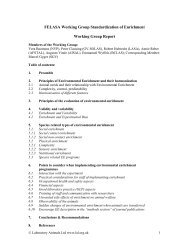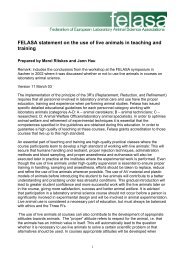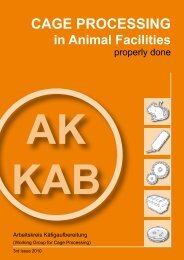CAGE PROCESSING in Animal Facilities - Felasa
CAGE PROCESSING in Animal Facilities - Felasa
CAGE PROCESSING in Animal Facilities - Felasa
- No tags were found...
Create successful ePaper yourself
Turn your PDF publications into a flip-book with our unique Google optimized e-Paper software.
For reasons of odour, exhaust air of the steam sterilisation process (com<strong>in</strong>g from the vacuum pumps) shouldbe discharged to atmosphere through a second, separate pipe. The same is recommended for exhaust air ofH 2O 2/ PAA locks. The type of air discharge open<strong>in</strong>g as well as its proximity to surround<strong>in</strong>g build<strong>in</strong>gs must bewell considered <strong>in</strong> order to avoid a recirculation through air condition<strong>in</strong>g <strong>in</strong>take vents or open w<strong>in</strong>dows, alsowhen weather conditions are unfavourable.The manufacturer must provide the customer with <strong>in</strong>formation on:• volume flow <strong>in</strong> m 3 /h,• exhaust air temperature,• exhaust air humidity,• connection dimensions.When pipes suffer high pressure loss, the customer should consider <strong>in</strong>stall<strong>in</strong>g an additional fan at the end ofeach affected pipe.The different amounts of exhaust air (general exhaust air com<strong>in</strong>g from the process<strong>in</strong>g centre, exhaust air com<strong>in</strong>gfrom mach<strong>in</strong>es or from handl<strong>in</strong>g bedd<strong>in</strong>g) must be taken <strong>in</strong>to account <strong>in</strong> order to ma<strong>in</strong>ta<strong>in</strong> the desiredrelative room air pressure.Note: Special care <strong>in</strong> the choice of the material of build<strong>in</strong>g exhaust air duct which have contact with H 2O 2isessential.5.2.8 Heat dissipationHeat emitted by the mach<strong>in</strong>es must be dissipated. If the heat is dissipated by extraction of air, fresh air mustbe fed back <strong>in</strong> <strong>in</strong> order to avoid overheat<strong>in</strong>g (> 50 °C) <strong>in</strong> the service room. When design<strong>in</strong>g the capacity of theventilation system, not only the heat of the mach<strong>in</strong>es is to be considered, but also the heat com<strong>in</strong>g from theitems to be processed.The manufacturer must provide the operator with <strong>in</strong>formation on:• heat emitted by the mach<strong>in</strong>es (eg. <strong>in</strong> kW).5.3 Construction dimensions, load-carry<strong>in</strong>g capacity, and pitThe manufacturer must provide <strong>in</strong>formation on the <strong>in</strong>stallation dimensions, weight and operational weight ofeach process<strong>in</strong>g mach<strong>in</strong>e so that room dimensions, structural load of the slab and ceil<strong>in</strong>g can be calculated.This also applies for the m<strong>in</strong>imum dimensions and loads of the transport route (façade open<strong>in</strong>g, halls lead<strong>in</strong>gto the <strong>in</strong>stallation site, etc.). A potential replacement of mach<strong>in</strong>es at a later time, after the build<strong>in</strong>g is f<strong>in</strong>ished,must also be taken <strong>in</strong>to account.It is recommended for the operator to equip mach<strong>in</strong>es with floor level access with a watertight pit. The edgesof the pit must be sealed with non-rust<strong>in</strong>g re<strong>in</strong>forcements. The pit must be designed accord<strong>in</strong>g to manufacturer<strong>in</strong>structions with a pit dra<strong>in</strong> and odour trap. A common pit depth ranges up to 250 mm.The manufacturer must provide the customer with <strong>in</strong>formation on:• required pit dimensions, <strong>in</strong>clud<strong>in</strong>g position of dra<strong>in</strong>.5.4 Ma<strong>in</strong>tenance access and service roomFor ma<strong>in</strong>tenance work <strong>in</strong>side the mach<strong>in</strong>e, the access for eng<strong>in</strong>eers and ma<strong>in</strong>tenance personnel specified bythe manufacturer must not be obstructed by additional <strong>in</strong>stallations (e.g. ventilation ducts, pipeworks, cabletrays). In walk-<strong>in</strong> service rooms, a light and socket with protection category IP54 must be <strong>in</strong>stalled.5.5 Dispens<strong>in</strong>g station for process chemicalsProcess chemicals can be dispensed centrally or locally. When select<strong>in</strong>g a local dispens<strong>in</strong>g system, the trad<strong>in</strong>gunits should be placed next to the washer or <strong>in</strong> the service room. For deliveries of large conta<strong>in</strong>ers, theaccess doors should be of sufficient size (barrel and pallet dimensions must be considered).The advantage of central dispens<strong>in</strong>g stations is that they can provide different washers with process chemicalsfrom one large trad<strong>in</strong>g unit. Usually, dispens<strong>in</strong>g stations are situated <strong>in</strong> a separate room that should be wellCage Process<strong>in</strong>g <strong>in</strong> <strong>Animal</strong> <strong>Facilities</strong> · 4th issue · 2013 41






